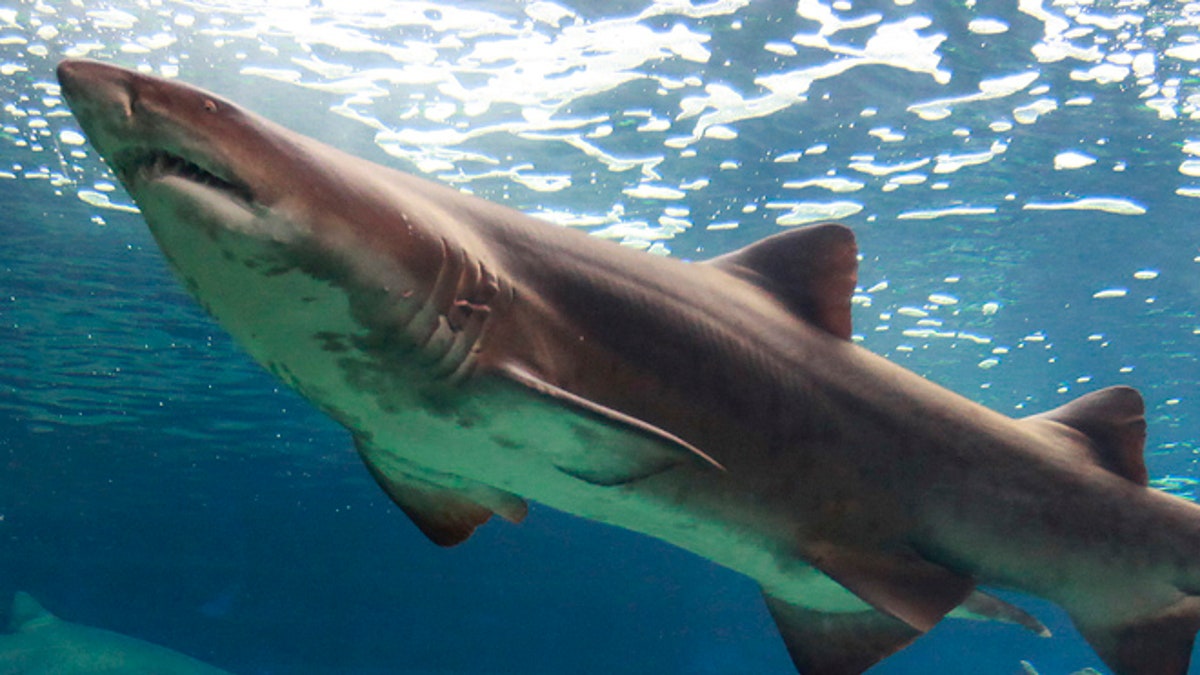
April 6, 2014: People look at a sand shark inside a tank of fish at the Cretaquarium in the city of Iraklion, on the Greek island of Crete. (AP)
Sharks turn out to be more modern and sleek than anyone had ever imagined, given a new study that negates a prior theory that today’s sharks are “living fossils,” changing little over time.
Instead, like the latest and greatest electronic devices or sports cars, modern sharks have acquired useful and eye-catching features stemming from evolutionary innovation.
According to the study, published in the journal Nature, sharks have not retained a primitive anatomical state, but have substantially changed during their lengthy time on the planet.
Photos: 5 Sharks, Rays Needing Urgent Protection
“Sharks were considered for a long time as ‘living fossils’ that should not have changed a lot, but they have probably more than 420 million years of evolution behind them!” lead author Alan Pradel told Discovery News, adding that maybe our fantasy of a “scary living fossil from the abyss” helped to popularize the older view.
The key to solving the puzzle is a newly identified 325-million-year-old shark-like creature named Ozarcus mapesae. The name pays homage to the Ozark region of Arkansas, where its remains were found. The name also honors paleobiologist Gene Mapes who has collected and studied fossils for over 40 years. Her husband Royal, an invertebrate paleontologist, is a co-author of the paper.
Shark-like species started to emerge around 440 million years ago, with the first true sharks coming onto the scene about 300 million years ago. It’s currently unclear which species was the world’s first shark, but a dogfish-resembling hunter called Tristychius is a strong contender for that distinction.
Prehistoric Shark Looked Like the Devil
Ozarcus lived close to when the true shark first emerged. Ozarcus was small, about 12 to 20 inches long, and it lived not far from shore in shallow seawaters. Like actual sharks, it was a hunter with a big mouth and many teeth. Upon closer look, however, it also shared features with bony fish.
Pradel, a vertebrate paleontologist at the American Museum of Natural History, and his colleagues paid particular attention to skeletal features known as visceral arches. They support the jaw and gills.
“These arches are thought to have given rise to jaws early in the tree of life,” he said.
The arrangement of these skeletal features in Ozarcus resembles that of bony fish, so it can now be inferred that the common ancestor of bony fishes and cartilaginous fishes was more like a bony fish than a shark. Bony fishes may then provide greater clues about our first jawed ancestors than modern sharks do.
This is significant, especially for researchers working to unravel the early stages of vertebrate evolution. One such scientist is Philippe Janvier, a vertebrate paleontologist at the Museum National de l’Histoire Naturelle in Paris.
Janvier told Discovery News that “we are probably confronted with a radical change in our views about what is primitive and what is advanced in jawed vertebrate evolution.”
Top 10 Most Incredible Shark Journeys
He and his colleagues are now beginning to consider that “sharks and their allies may well be the anatomically most advanced jawed vertebrates, which evolved through a considerable reduction of their ability to produce bone,” Janvier said.
Without heavy bones, sharks evolved into faster, lighter and more flexible hunters.
Many exhibit what Pradel calls a “fusiform” shape, meaning wider in the middle and tapered at the ends. Most sharks have this streamlined shape, as do tuna, dolphins and certain other swift-swimming predators.
It’s possible, but not likely, that sharks could de-evolve their traits. Species can undergo so-called backward evolution into more “primitive” forms over time, depending on what features best support current conditions. What’s even more essential is that the evolution of a species can keep up with environmental shifts, such as climate change.
Sharks—even with their modern features—tend to repopulate slowly, making them extremely vulnerable to overfishing, climate change and other human-affected threats.




















